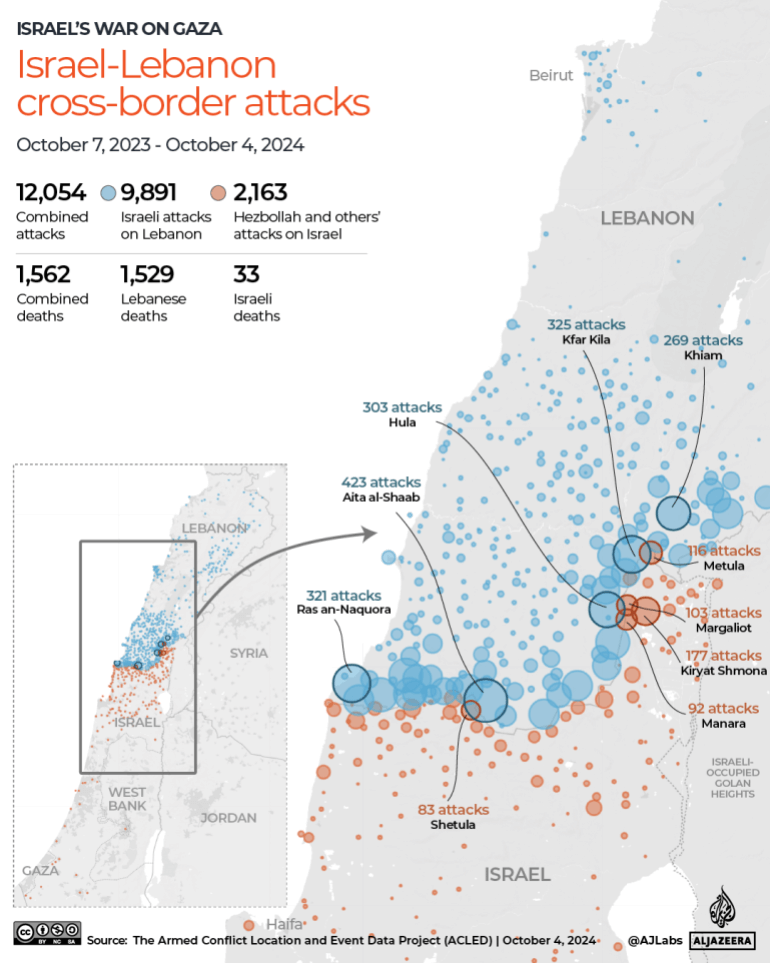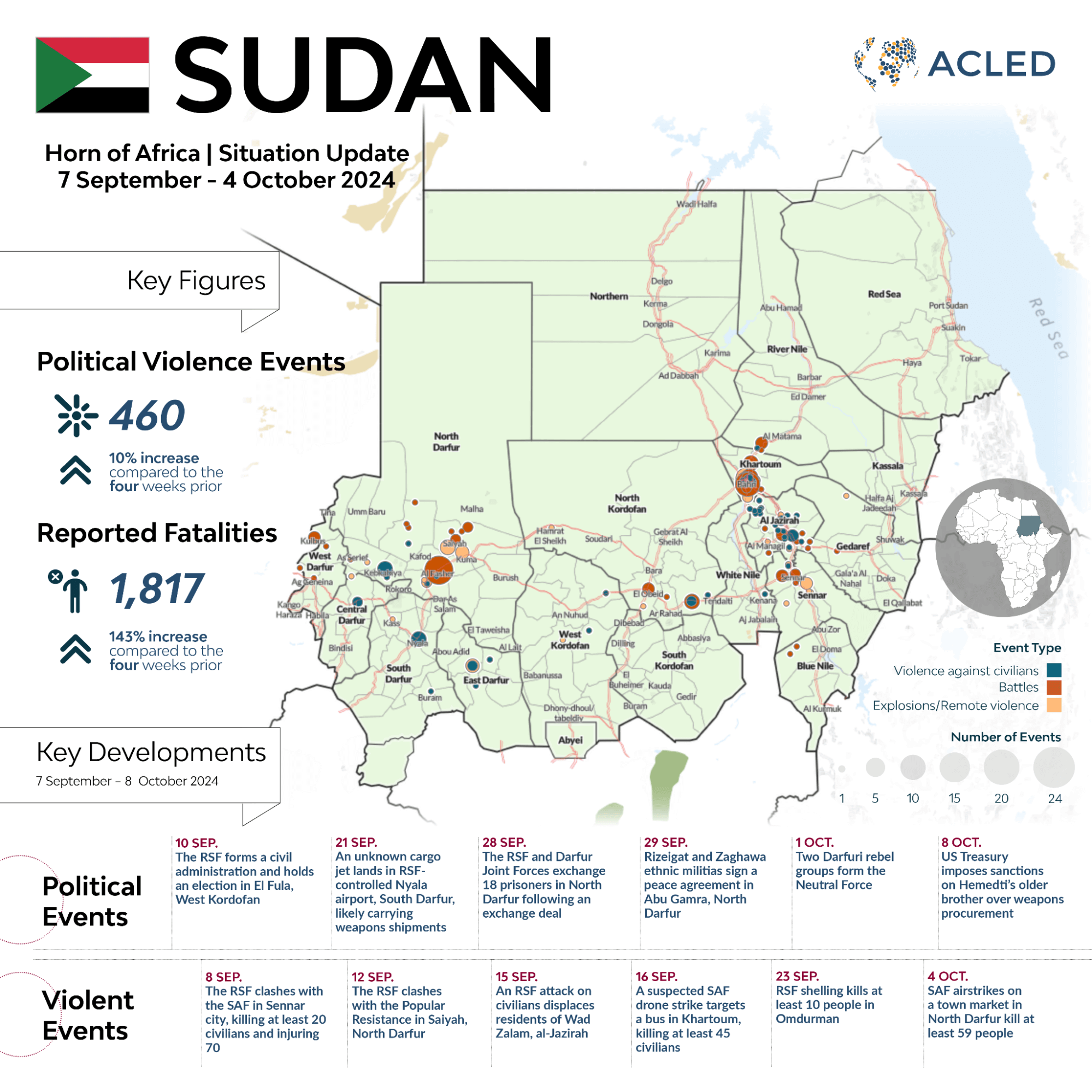Clionadh’s Monthly ACLED Data & Analysis Outlook
Dear readers,
We are in the final quarter of 2024 — also known as ‘the year with the most elections in modern history.’ The world is not just awash with ballots, but conflict, ‘survival politics’, violent competition, alliance building and breaking. From the streets of Khartoum to political crises like Haiti’s, the interplay between politics and violence is more visible than ever.
This month, we highlight 2024’s main conflict contenders.
Middle East: Hamas and the continued war in Gaza
It has been a year since Hamas launched its deadly attack on Israel that spurred this conflict. ACLED has organized a central place for information on this conflict where information on Gaza, and regularly updated metrics, maps, and insights on the Lebanese front, Syria, Yemen, and Iran are available. This conflict has developed so many tentacles and fronts that this resource is invaluable for keeping up.
The crisis in Gaza has reached alarming proportions for civilians, and clashes continue in Gaza and the West Bank, where Hamas-linked violence has surged by over 130% in the past year. Our recent report holds that Hamas may still retain nearly half of its fighters, and continues to harass Israeli forces through attacks, explosives, and tunnel-based operations. Yet, key leaders were recently killed, most notably Hamas’ Yahya Sinwar in Gaza, and Hezbollah’s Hassan Nasrallah in Lebanon. These deaths will have massive effects on the trajectory for both groups, and have led to a surge in what I like to call ‘bastard obituaries’ where writers struggle to emphasize, but not admire, the life histories of very violent men.
Hezbollah, in particular, is/was the world’s largest non-state armed group, and has paid a large price for Hamas dragging it into this conflict (see Al Jazeera visual below based on ACLED data). In turn, the benefactor of both groups — Iran — is struggling to secure its own survival by visiting known Arab enemies and asking for non-alignment should Israel attack their regime.
Sudan: Setbacks and strategies
We have recorded more than 25,000 fatalities from the Sudan conflict after 17 months of warfare between the Sudanese Armed Forces (SAF) and the Rapid Support Front (RSF) for control of the country and government. This is surely an underestimate based on reported figures, as we know more than 10 million children have been exposed to conflict in Sudan, and 38% of Sudan’s population is directly and repeatedly exposed.
A new stage is developing after months of intensive military buildup, including training new recruits and securing fighter jets from Russia and Egypt, and the SAF appears to have regained some traction. It launched its largest coordinated offensive yet, achieving significant gains in the Khartoum region and opening new fronts in North and West Darfur. But the RSF remains entrenched in Darfur, and parts of Kordofan.
Haiti: Gang alliances and rising violence
On 3 October, the Gran Grif gang attacked residents in Pont-Sondé, killing at least 115 people in the deadliest incident in the Artibonite department since ACLED began collecting data for Haiti in 2018. The gang was retaliating against residents accused of collaborating with a local self-defense group. These self defense groups are very common in countries where the security sector has failed — and in Artibonite, despite warnings, security forces arrived 24 hours after the massacre. Gran Grif has been responsible for 80% of deaths in events targeting civilians in the region since 2022.
Since the formation of the Viv Ansanm alliance in late 2023, Haiti’s gang landscape has shifted. Rival factions like G-9 and G-Pèp united, leading to a 78% drop in gang-on-gang clashes and expanded control over nearly 100 neighborhoods in Port-au-Prince. However, this truce hasn’t spared civilians. Kidnappings surged in July, and attacks on police stations and government buildings tripled.
Gang violence extends beyond Haiti – Jamaica, Puerto Rico, and Trinidad and Tobago are also experiencing significant gang activity, fueled by drug trafficking and weapons proliferation. Upcoming elections in Jamaica and Trinidad and Tobago beg the question of how to hold a fair election in the midst of gang problems.
Further up north: As I’ve signaled in previous editions of this report, the US election is projected to unfold without the high levels of organized political violence seen in recent years. ACLED data supports this outlook, with US expert Kieran Doyle noting that extremist mobilization remains low even with the year’s most anticipated election just days away.
Notes and notions
ACLED is pleased to announce a new two-year grant from the UN based Complex Risk Analytics Fund (CRAF’d). This supports our global, open conflict monitoring efforts through July 2026, and allows us to maintain our real-time data collection, expand local partnerships in conflict zones, and improve data literacy worldwide.
In ‘unseen’ conflicts, this month we have put together some terrific resources on the Ambazonian separatist groups in the Anglophone region of Cameroon, focused on illicit economies. This includes a report with our partners at GI-TOC, a webinar, and a Q&A. This is the third of three such reports with GI-TOC: the first installment in this series analyzed the al-Qaeda-affiliated Jama’at Nusrat al-Islam wal-Muslimin (JNIM) in the Sahel and the second installment examined the dynamics of armed banditry in northwest Nigeria. A related webinar was held yesterday (you can watch the recording if you missed it) on this fantastic and insightful report on how ISIS in the Sahel has restructured to be more deadly.
Another webinar worth your time is our recent discussion of Rwanda and its role in both DR-Congo and Mozambique as the regional security guarantor.
Beyond ACLED work, a recent must-read is this tragic story about the chosen task of recording holocaust murders at the edge of a Lithuanian forest.
And be sure to watch this brilliant discussion at CSIS of why the leadup to the Ukrainian war was full of opinions and analytical failures; this military discussion is well placed next to Bob Woodward’s new book ‘War’, which is very readable and gossipy. Both are full of examples of how political speech to ‘sell war’ involves a lot of unsubstantiated strong public messages, and a mountain of private doubts.




